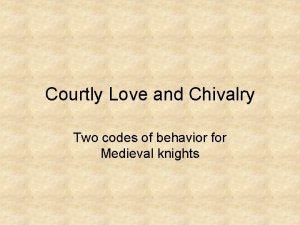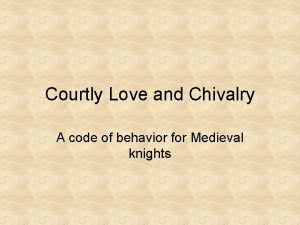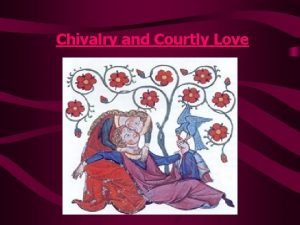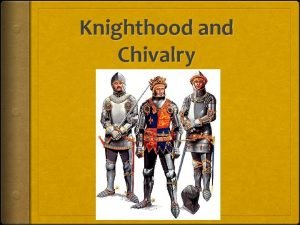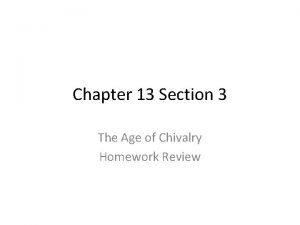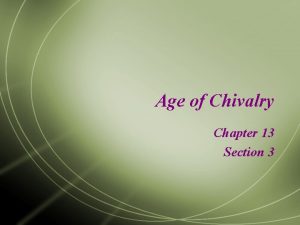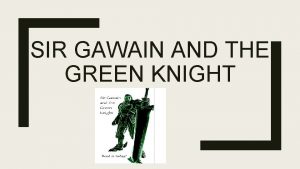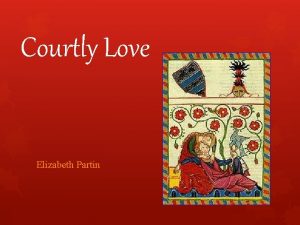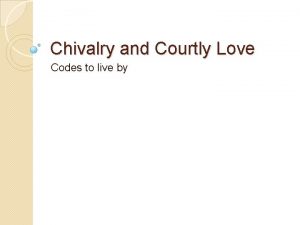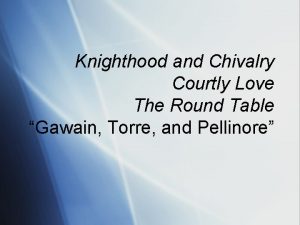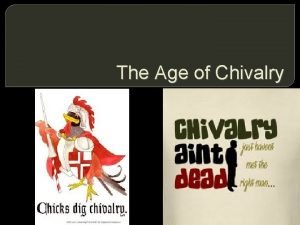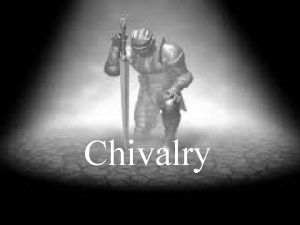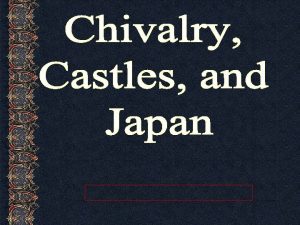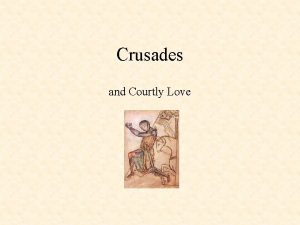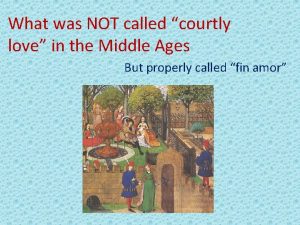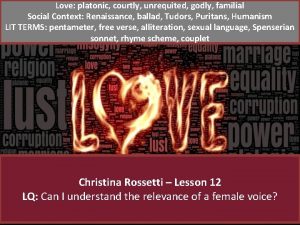Chivalry and Courtly Love What do you need

























- Slides: 25

Chivalry and Courtly Love

What do you need to know? • Chivalry was important to the middle ages knights • It was a code of conduct • There were rules attached to it in how you treated others • Courtly love was a subset of chivalry

The Knights Code of Chivalry and the vows of Knighthood • • • To fear God and maintain His Church To serve the liege lord in valour and faith To protect the weak and defenceless To give succour to widows and orphans To refrain from the wanton giving of offence • To live by honour and for glory

The Knights Code of Chivalry and the vows of Knighthood • • • To despise pecuniary reward To fight for the welfare of all To obey those placed in authority To guard the honour of fellow knights To eschew unfairness, meanness and deceit • To keep faith

The Knights Code of Chivalry and the vows of Knighthood • • • At all times to speak the truth To persevere to the end in any enterprise begun To respect the honour of women Never to refuse a challenge from an equal Never to turn the back upon a foe Refrain from the wanton giving of offence To live by honour and for glory To despise pecuniary reward To fight for the welfare of all To obey those placed in authority

Why? • With a partner, answer this question: – Why is it important in the middle ages to have this system in place? – Prediction: Where did chivalry and courtly love originate? – What do you think courtly love is?

Courtly love—the art of romance which was practiced by the members of the European courts during the middle ages. Referred to a specific set of rules governing relationships between men and women that were meant to be chaste and pure Ideal Love

History • Eleanor of Aquitaine • Practiced in England between 1300 -1500 • Why was it needed? – Since marriages were built not on love but on material connections; courtly love provided a way for men and women to experience romance outside of marriage

• Fidelity and chastity were still considered important Respect the rules: or else so. . . • In other words, have fun but don’t get caught. • If caught, a woman would be in trouble with her husband, brother, church, and the king or queen and could be punished for infidelity • That’s why you were supposed to look , but not touch

Partner work • • • Review: What is courtly love? Where did it originate? Why did they have this system? Do you think chivalry and courtly love ideals still exist today? Why or why not?

The Stages of Courtly Love • Attraction to the lady, usually via eyes/glance • Worship of the lady from afar • Declaration of passionate devotion • Virtuous rejection by the lady • Renewed wooing with oaths of virtue and eternal fealty • Moans of approaching death from unsatisfied desire (and other physical manifestations of lovesickness) • Heroic deeds of valor which win the lady's heart • Consummation of the secret love • Endless adventures and subterfuges avoiding detection

The Twelve Rules of Love from The Art of Courtly Love by Andreas Capellanus • 1. Thou shalt avoid avarice like the deadly pestilence and shalt embrace its opposite. • 2. Thou shalt keep thyself chaste for the sake of her whom thou lovest. • 3. Thou shalt not knowingly strive to break up a correct love affair that someone else is engaged in. • 4. Thou shalt not chose for thy love anyone whom a natural sense of shame forbids thee to marry. • 5. Be mindful completely to avoid falsehood.

Rules continued • • 6. Thou shalt not have many who know of thy love affair. 7. Being obedient in all things to the commands of ladies, thou shalt ever strive to ally thyself to the service of Love. 8. In giving and receiving love's solaces let modesty be ever present. 9. Thou shalt speak no evil. 10. Thou shalt not be a revealer of love affairs. 11. Thou shalt be in all things polite and courteous. 12. In practicing the solaces of love thou shalt not exceed the desires of thy lover.

Three "Not so good" Things About Courtly Love 1. Unrealistic and adulterous • Typically the courtly love relationship was not between husband wife. • Although this aspect bothers modern readers more than past readers. 2. Gender stereotypes • Put women on a pedestal; Mary figure; unobtainable • Made men appear ridiculous; pursuer 3. Distraction: it kept the knight from reaching his full potential.

The Literary Convention of Courtly Love • - In France and England, courtly love became a central theme of lyric and epic poetry. • - The literary convention of courtly love appears in works of most of the major authors of the Middle Ages including Geoffrey Chaucer (The Canterbury Tales). • - Courtly love conventions are found in the medieval genres of lyric, the allegory and the Romance (such as Sir Gawain and the Green Knight)

The Literary Convention of Courtly Love cont. • In the 12 th century, literature written in French was referred to as "romance" to differentiate it from "real" literature, which was written in Latin. • - Eventually, the term "romance" began to refer not to any literature written in French, but to the specific sort of literature that was popular among the French-speaking court audiences of France and Anglo-Norman England: stories of the chivalric adventures of knights and their ladies.

Romance Men • Physically strong hero/ • protector • Wise father-figure. • Super lover extraordinaire

Romance Women: The Good Girl Aloof princess in a tower • Courtly love places women on a pedestal, simply for the man to worship. She is not an individual because any analysis of her stops at her beauty. The man raises the woman up to a level that she cannot come down from and interact on a level with the rest of the world.

Romance Women: The Good Girl cont. Women as inhuman; otherworldly or perfect in some way Mother figure Virginal and sweet. Needs protection from evil Silent and adored by many

Romance Women: The Bad Girl • • • “mischievous” or “manipulative” The witch The whore (Madonna-Whore Complex) The temptress The adulterous

Connections: What is the difference between modern love and courtly love? Think about. . . Types of people involved Society’s rules regarding divorce and sex Perceptions about love And any others that you can think about

Group work • Consider different stories, books, and movies: how is love portrayed in these? • Do you see any similarities to the concepts of courtly love?

The Wife of Bath • Read the Wife of Bath • As you read, complete a question mark graphic organizer using complete thoughts and ideas • On back of page, answer this question: • Are the characters believable? Why or why not? (analyze knight, the queen, and the old woman) • What evidence of courtly love and chivalry (or lack thereof) do you see here? Find quotes to support yourself.

Courtly Love in Sir Gawain and the Green Knight • - Some argue the poet’s term “courtesy” can be likened to the idea of courtly love. • Summary: As a perfect knight in the service of the Virgin Mary, Gawain is caught in the tension between courtly love’s code of behavior, the expectations of duty and courtesy, and the strict moral demands of Christianity. (Does he choose the real woman to adore or should he stay true to Mary, mother of Jesus).

• - In Sir Gawain and the Green Knight, Sir Gawain must respect both the laws concerning courtly love and the laws of chivalry. • - The knight’s code of honor requires that Sir Gawain do whatever a lady asks, and because of this Gawain must accept the girdle from the Lady, but he must also keep the promise he has made to his host that he will give whatever he gains that day. • - When Gawain chooses to keep the girdle, he is breaking his promise to the host but honoring the lady. After learning that the Green Knight is actually his host, Gawain realizes that even though he has accomplished his quest, he has failed to be virtuous. • - This demonstrates the conflict between honor and knightly duties. By breaking his promise, Gawain believes he has lost his honor and failed in his duties.
 Code of chivalry and courtly love
Code of chivalry and courtly love Code of chivalry
Code of chivalry Code of chivalry
Code of chivalry Courtly love tradition
Courtly love tradition Romeo and juliet courtly love
Romeo and juliet courtly love Courtly love in modern movies
Courtly love in modern movies Courtly love arthurian legend
Courtly love arthurian legend All i need is the air that i breathe and to love you abba
All i need is the air that i breathe and to love you abba Love love jesus is love god greatest gift lyrics
Love love jesus is love god greatest gift lyrics Edna st vincent millay love is not all
Edna st vincent millay love is not all That you must love me and love my dog summary
That you must love me and love my dog summary You say you love rain
You say you love rain Thomas hood courtly queen
Thomas hood courtly queen To counterfeit a courtly kind of grace
To counterfeit a courtly kind of grace Love begets love
Love begets love How does a knight look like
How does a knight look like I wish you strenght
I wish you strenght Examples of inverted commas
Examples of inverted commas You are good you are good and your love endures
You are good you are good and your love endures Chapter 13 section 3 guided reading the age of chivalry
Chapter 13 section 3 guided reading the age of chivalry Knight in feudal society education
Knight in feudal society education David dumville
David dumville Samurai vs knight venn diagram
Samurai vs knight venn diagram Mrs fountain
Mrs fountain In this excerpt from sir gawain and the green knight
In this excerpt from sir gawain and the green knight Chivalrous in a sentence
Chivalrous in a sentence
